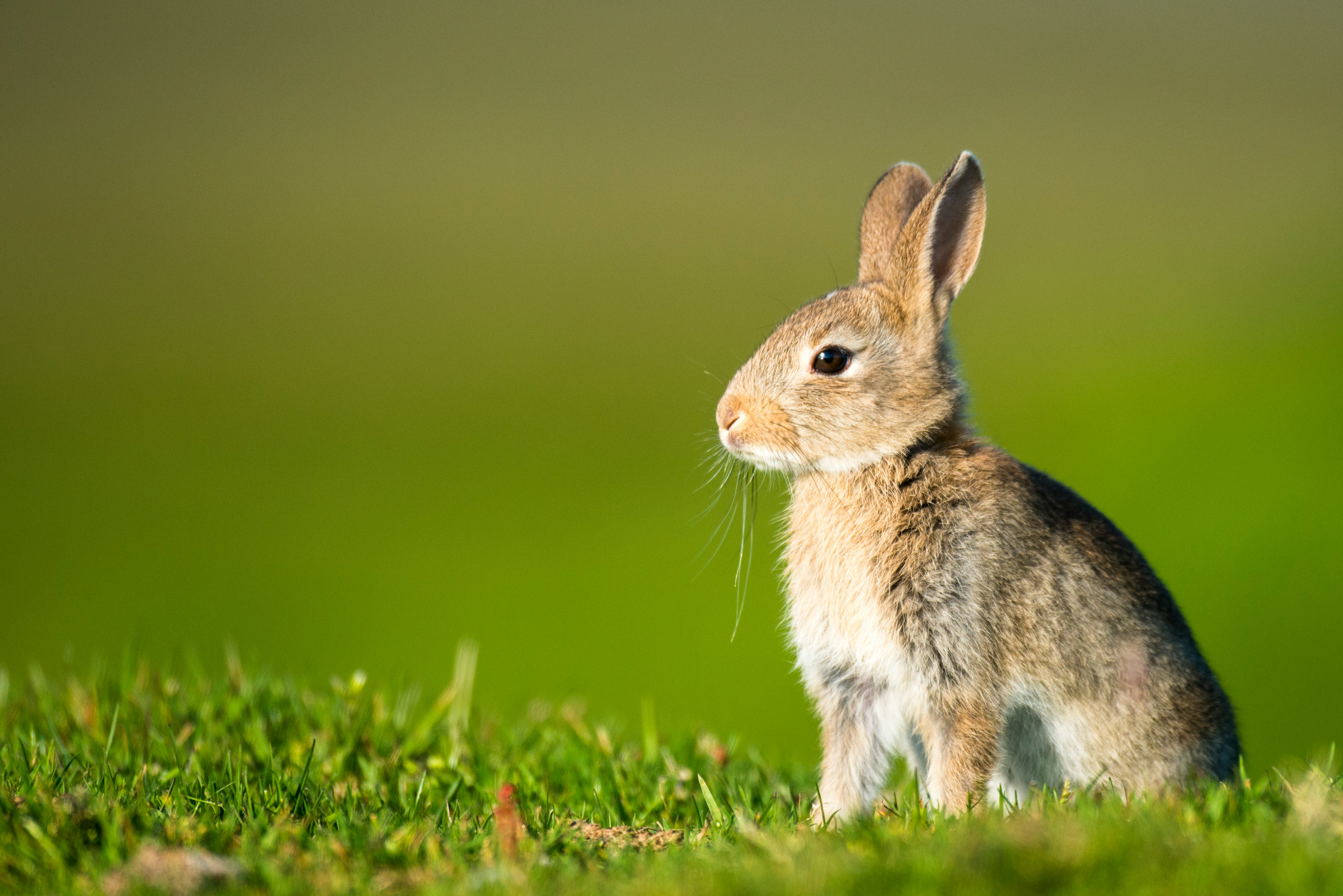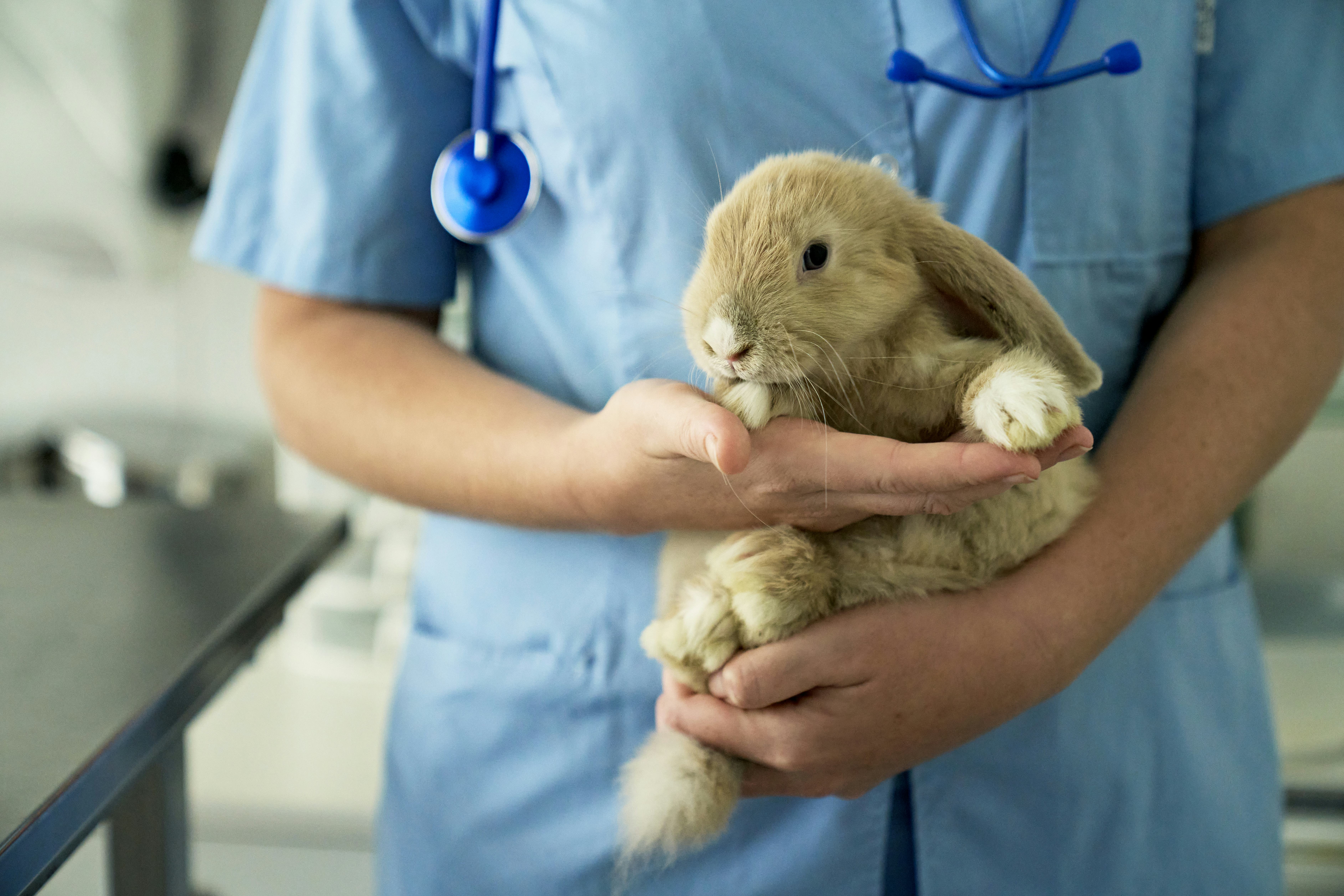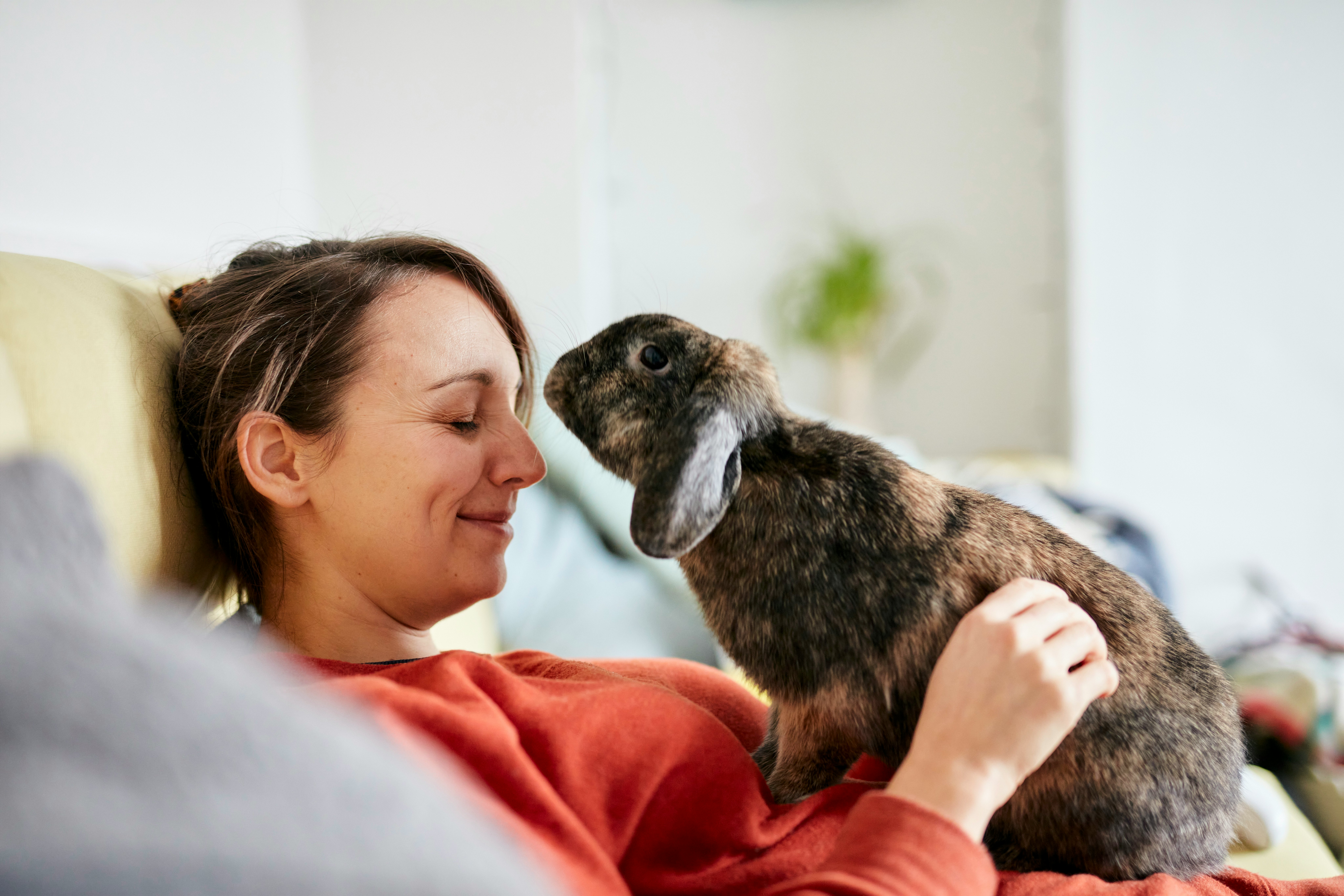
Just as the worldwide Covid-19 pandemic took hold in spring 2020, another disease was striking the United States — but this one was affecting rabbits. RHDV2, a type of highly fatal rabbit hemorrhagic disease, was detected for the third time in the U.S. in February 2020. Unlike the previous two cases, this one was spreading quickly.
“I hadn’t heard of RHDV2 until the pandemic. They sort of correlated, the two pandemics — the human and the bunny one,” Katherine Filaseta, a rabbit owner based in New York City, tells Inverse. (Filaseta is a friend of the author.)
Lauren Goldberg, a rabbit owner in Portland, tells Inverse, “We were kind of like — this is Covid for rabbits.”
Over the past two years, RHDV2 has spread far and wide to at least 21 states, but a U.S-made vaccine was also approved for the disease last year for most states. Inverse spoke with rabbit owners and veterinarians to share tips and concerns about protecting bunnies from the deadly virus. Here’s everything you need to know about the rabbit disease RHDV2 — a disease every bunny owner should know about, veterinarians say.
“We are extremely concerned about RHDV2,” Michelle Kelly, founder and president of the Los Angeles Rabbit Foundation, tells Inverse.
What is RHDV2?

RHDV stands for “Rabbit hemorrhagic disease virus,” referring to a highly contagious and fatal disease affecting pet rabbits, hares, and wild rabbits like European rabbits and cottontails. Alisa Rassin, owner and medical director of the Exotic Animal Hospital of Philadelphia, tells Inverse that RHDV is a virus from the Caliciviridae family — a lineage of RNA viruses.
The House Rabbit Society — a nonprofit organization that serves as a leading resource for rabbit owners in the U.S. — says on its website that rabbit hemorrhagic disease first appeared in China in 1984 and has since spread to 40 countries in Europe, Africa, Asia, and North America. RHDV1 and RHDV2 are two common strains of rabbit hemorrhagic disease, but RHDV2 has become more prevalent in the U.S only since 2020. RHDV1 only affects European rabbits (Oryctolagus cuniculus) — the progenitor of domestic rabbits in the U.S. — but RHDV2 affects hares as well.
“RHDV2 seems to be more fatal and act faster than RHDV1 with shorter incubation periods and minimal clinical signs prior to sudden death,” Rassin says.
Importantly, RHDV2 poses no threat to the health of humans or other common pets like dogs or cats, though humans and animals could transmit the disease to rabbits if they came in contact with a sick bunny.
“RHDV2 affects rabbits and hares only, no other animals,” Sari Kanfer, a veterinarian and small mammal expert at Exotic Animal Veterinary Center, tells Inverse.
But RHDV2 is highly transmissible and lethal for wild and domesticated rabbits. The disease affects clotting and can cause cell and tissue death, particularly affecting the liver and spleen. RHDV2 in the U.S. has a fatality rate of up to 90 percent according to the Los Angeles Rabbit Foundation, but the lethality can vary depending on a population’s natural resistance to the disease.
According to the House Rabbit Society, the disease has an incubation period of three to five days and death typically occurs within five days after symptoms show up. Rabbits that survive — including asymptomatic bunnies — may shed the virus for two months after becoming infected, posing a serious risk to other rabbits around them.
“Owners should be very concerned. It only takes a few virus particles to cause acute illness and death,” Kanfer adds.
The history of RHDV2
According to the USDA, RHDV2 — also known as RHDVb — first emerged globally in France in 2010 and spread to the rest of Europe, but the disease didn’t make its way to North America until 2016, when cases were detected in Quebec, Canada. A different strain of RHDV2 appeared in British Columbia in 2018. The virus later spread to Washington state in the U.S. between July and December 2019. It’s plausible the virus spread from British Columbia in Canada to neighboring Washington state, but we can’t say for certain.
“Sources of introduction [to North America] are unknown,” reports the USDA.
The current outbreak in the U.S really took off in 2020. In February 2020, the virus was detected in New York, and the following month, RHDV2 was detected in 11 rabbits in a veterinary clinic in New York City, all of whom died from the disease. Cases also began cropping up in the southwestern US in March 2020 before emerging in other parts of the country.
The USDA and Wildlifehealth.org — a network of wildlife health officials — offer maps of current RHDV2 outbreaks in the U.S., but these maps were last updated in March and April respectively, missing out on states like New Jersey, where state authorities reported the virus occurring in May of this year. As of May, RHDV2 has been detected in at least 21 states ranging far across the country from California to Florida.
“The disease is continuing to spread and it's a matter of time until it reaches every state in the country,” Rassin says.
How does RHDV2 spread?
For a bunny to become infected with RHDV2, it must either directly or indirectly come into contact with another sick bunny (or the dead carcass of an infected rabbit). RHDV2 can survive in “extreme temperatures” and is therefore highly transmissible, according to Rassin.
Here are the common ways that RHDV2 spreads:
- Direct contact with an infected bunny or the carcass of a dead rabbit
- Exposure to the feces or blood of a sick bunny
- Indirect contact: A bunny coming into contact with another pet or animal — including insects like mosquitoes or flies — or a human that has been exposed to an infected rabbit
- Through fomites/contaminated materials — such as clothing, shoes, hay, or surfaces — or food or water that has been exposed to the virus
“People can spread the virus indirectly by carrying it on their clothing and shoes,” Rassin says.
Kurt Sladky, a clinical professor of zoological medicine at the University of Wisconsin, says that bunny owners should also be cautious about the sourcing of the hay they use for their bunnies’ enclosures.
“I cannot say for sure that the virus can live on hay for a prolonged period of time, but it would be prudent as a pet rabbit owner to purchase packaged hay rather than purchasing bulk hay,” Sladky says.
Sladky says zoologists are still figuring out all the ways RHDV2 can spread, so until they do, it’s better to exercise caution. Sladky offers an RHDV2 vaccination clinic at the University of Wisconsin.
“Therefore, we are suggesting that pet rabbit owners do not allow their rabbits access to the outside,” Sladky says.
What are the common symptoms of RHDV2?
Rabbits may not present obvious symptoms of RHDV2, so it’s up to pet owners to stay extra vigilant about any change in their pet’s behavior or mood. Although, sadly, the most common symptom of the virus is sudden death.
Here are the most common symptoms of the virus, according to Rassin and Kanfer:
- High fever
- Lethargy/fatigue
- Spasms
- Loss of appetite
- Blood coming from the nose, rectum, and mouth
- Sudden death
If your pet presents any of the symptoms above, contact your veterinarian immediately and quarantine your rabbit from any other bunnies in the household.
Is there a vaccine for RHDV2 in the U.S.?

Yes. Medgene Labs — an immunological services provider that creates vaccines for animal diseases — is the first and only U.S. company to create a vaccine for the disease. It made the vaccine available beginning in 2021 after receiving emergency use authorization from the USDA. The vaccine is currently available to veterinarians in 43 states and the District of Columbia, according to its website. The Medgene vaccine is a two-dose injection. Rabbits should receive a second dose or booster 21 days after the first shot.
According to Jason Melby, marketing director for Medgene Labs, before the company received authorization for the vaccine, the USDA allowed a special export of European-made vaccines. The USDA ceased issuing permits for the import of European vaccines once the Medgene vaccine became available.
The vaccine works by targeting “protective proteins” in the RHDV2 virus, according to Melby. Rassin adds that rabbits who received the RHV1 vaccine must also receive the RHDV2 vaccine since there is no cross-immunity between the two strains.
“Our vaccine technology does not require the use of live RHDV2 virus, or live animals for production,” Melby says.
In a study that Medgene conducted before the vaccine received emergency use authorization, all of the rabbits that received the vaccine survived, whereas 69 percent of rabbits receiving the placebo — the non-vaccinated rabbits — died. The vaccine has a very high degree of efficacy according to this research, though that study has not been peer-reviewed. Side effects appear to be minimal if any.
“We have not observed any side effects from the vaccine,” Sladky says.
Some rabbits that are not used to going outside the home for veterinary visits may experience stress due to the travel. Melby adds, “Rabbits may develop a small swelling at the site of the injection, develop a slight temporary fever, or be lethargic for a day or two.”
Sladky says he has vaccinated more than 100 rabbits since the University of Wisconsin began offering vaccines earlier this year.
“The vaccine became available in Pennsylvania in November 2021 and we have vaccinated the majority of our client-owned rabbits and many of the rescues we work with closely,” Rassin says.
Why didn’t we get the vaccine earlier?
Some rabbit owners, like Filaseta, were confused about the lack of available vaccines for American rabbits until recently, even though bunnies in Europe and other parts of the world had already been regularly receiving RHDV2 vaccines for years due to the prevalence of the virus there. But Melby says it can take five to eight years to approve a commercial animal vaccine in the U.S due to USDA regulations.
“The USDA standards for vaccines are very thorough and require specific trials and studies to ensure they are both effective and safe for animals before being approved for use,” Melby says.
Rassin currently works as a veterinarian in the U.S. but had been practicing in the UK between 2016 and 2019.
“Other European countries might have had earlier outbreaks, so thankfully, by the time it reached London, the vaccine was already in use and we were able to start vaccinating right away,” Rassin says.
Lisa Severing, a rabbit owner in Munich, Germany, says she got her first rabbit roughly two years ago from a breeder and the second from a shelter. Because her rabbits already received the vaccine when she got them, Severing was not too concerned about RHDV2.
“They already were vaccinated and we got the next shot when we had the regular check-up. I go about every year. It is standard procedure here,” Severing tells Inverse.
Organizations like the Los Angeles Rabbit Foundation — a rabbit foster and adoption organization — say the lack of vaccinations for rabbits in the U.S. prior to RHDV2 means that bunny owners are not used to taking their pets to the veterinarian for regular immunization, unlike in other countries.
“It's important to recognize that in the U.S., we have until 2020 never vaccinated rabbits,” Kelly says.
The House Rabbit Society requires all its foster rabbits to receive the RHDV2 vaccination and they get annual boosters as well.
“In order to adopt a second rabbit from us, prospective adopters must show that their current rabbit is both neutered and vaccinated,” Kelly adds.
How to protect your pet from RHDV2
According to Kelly, there are three ways to protect your pet from rabbit hemorrhagic disease:
- Vaccination
- Keeping bunnies indoors
- Biosecurity measures.
“Of these, vaccination is most effective as a preventative measure,” Kelly says.
If the vaccine is available in your state, you should immediately consult a veterinarian for further information on getting the vaccine — preferably from an exotic animal veterinarian that specializes in rabbit care. If there is an active outbreak of RHDV2 in your state, you may want to ask your veterinarian beforehand about measures they are taking to keep rabbits safe while going in for your pet’s annual check-up. Not every veterinarian currently offers the vaccine, so you may need to look around until you find one that does in your area.
The second measure — keeping rabbits indoors and away from other bunnies — is obvious. One of the main modes of transmission of RHDV2 is from other animals — including rabbits — so preventing your bunny from going outdoors is a necessary move. Avoid meetups with other bunnies and their owners until your pet is vaccinated.
Marley Teter is a rabbit owner in the California Bay Area. Although both of Teter’s rabbits are vaccinated, they stay indoors due to concerns about predators like hawks and bobcats. But Teter allows the rabbits to roam freely within the home.
“For me personally, the safest thing you can do for a bunny is to keep them inside you know. Let them hop all around the house as they please but not outside,” Teter tells Inverse.
The final method of RHDV2 prevention is biosecurity or taking proactive measures to reduce the transmission of the disease. You’re probably familiar with biosecurity by now due to Covid-19 mitigation measures like mask-wearing and social distancing.
The House Rabbit Society suggests a number of biosecurity measures to protect pets, including:
- Keeping pets indoors only
- Limiting contact with rabbits outside the home
- Washing your hands and changing before handling your rabbit
- Keeping cats — if there are any in your home — indoors and dogs on-leash to limit contact with infected bunnies or their feces
- Keeping shoes off in the home to limit the spread of fomites associated with the virus
- Keep bunnies protected from mosquitoes and flies using door/window screens and bug spray if needed
- Using approved disinfectant that can kill the virus
- Grooming rabbits — including nail trimming — at home
Goldberg says that she takes her shoes off after entering the home in case to reduce the risk of carrying the virus indoors. But Kelly also stresses that biosecurity measures alone may not protect pets. With such a highly fatal disease, getting pets vaccinated is crucial, especially as the virus continues to spread with no end in sight. Households with multiple rabbits are especially vulnerable due to the high likelihood of transmission between bunnies.
“As the recent cases in Washington State have shown, biosecurity and indoor-only housing will not protect every rabbit from RHDV2: In a household with multiple rabbits, only the vaccinated rabbit survived,” Kelly says.
How non-pet-owners can help prevent the spread of RHDV2
If you don’t own a rabbit, you can still help limit the spread of the disease, according to the website of the RHD Awareness Team — a group of wildlife researchers based in Georgia that receive funding from the USDA. Report any sick or dead rabbits — do not touch them — you encounter to a veterinarian or state wildlife agency. If a dead rabbit presents no obvious signs of trauma — or has blood around the nose and mouth — that may be a sign it contracted RHDV2.
The RHD Awareness Team also offers a resource guide for rabbit hunters with tips like wearing disposable gloves, taking measures for the safe handling of carcasses, and sanitizing equipment after hunting.
What concerns bunny owners about RHDV2?

Members of the rabbit community are concerned that other bunny owners may be missing out on vital information to protect their pets, owing to a lack of information in the media. Goldberg says that although her current veterinarian in Portland keeps her informed about RHDV2, allowing her to get her rabbit vaccinated, she didn’t have access to a regular veterinarian when she previously lived in New York.
“I would have no idea. If I wasn't following this one specific Instagram account, and if I didn't have this [bunny] group, I never would have heard of [RHDV2],” Goldberg says.
Kelly says that bunny owners whose veterinarians are not rabbit specialists or are not plugged into the broader bunny community through Facebook groups, breeder shows, or rescue groups may not know the serious threat RHDV2 poses to their pets.
“We find that people who've had rabbits for several years are not all aware of this disease or the need for the vaccination,” Kelly says.
Some bunny owners say they have relied primarily on privately-run Facebook groups and other social media outlets — like the House Rabbit Society’s Facebook page — to stay informed about the progression of the disease, though others reported that their veterinarians were good about updating them on the availability of a vaccine once it became available in their state.
As a rabbit owner, Filaseta says that it has been difficult to obtain the shot for her bunny due to the limited availability of vaccine clinics offered by her veterinarian. The two-dose requirement of the vaccine — the rabbit must receive a booster after 21 days — also poses a challenge due to Filaseta’s work schedule. Kanfer says that whether you can get a vaccine for your bunny during a regular check-up will depend on your veterinarian’s specific setup.
“Some veterinary hospitals perform vaccine clinics, some are giving the vaccine during regular visits,” Kanfer says.
Rassin says that “depending on you ask,” the USDA didn’t approve veterinarians keeping the Medgene vaccine — which comes in a multidose vial — open for more than 24 hours, which would make it difficult to administer the vaccine at regular check-in appointments as opposed to clinics.
“Some exotic veterinarians are now drawing up the vaccines into individual doses and cleaning the seal in between so they are able to offer the vaccine at individual exams as opposed to large vaccine clinics,” Rassin says.
For now, Filaseta’s rabbit remains unvaccinated. Since the bunny remains indoors and has not interacted with other rabbits since the emergence of the disease in New York, the risk is lower than for other bunnies, but she still worries about mosquitoes transmitting the disease to her pet.
What are other RHDV2 resources?
For further information and to stay up to date on the spread of the disease, you can visit the following websites:
- House Rabbit Society — a nonprofit organization that serves as a leading resource for rabbit owners in the U.S.
- RHDV2.org — a website run by the RHD Awareness Team
- Rabbitors — a website run by the r/rabbits subreddit that lists veterinarians offering the vaccine and upcoming RHDV2 vaccine clinics
- USDA factsheets containing information on the disease (note: these are from 2020 and some of the information on current outbreaks and vaccine availability may be outdated)
The Inverse analysis — RHDV2 is seriously scary, but there is a clear solution. In short: get your bunny vaccinated as soon as possible to protect them from the disease.
“I would recommend having bunny parents contact their local exotic veterinarian and ask if they have the vaccine in the hospital and when they can come in to receive it,” Rassin says.







